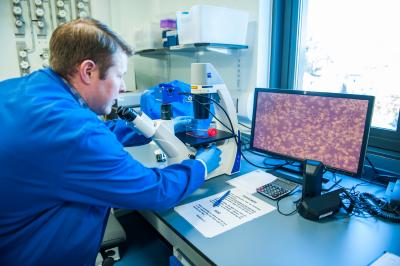Our immune system normally protects us against infection and illness. But in Type 1 diabetes, the immune system attacks the cells in the pancreas that make insulin – the hormone responsible for regulating levels of glucose in the blood.
Scientists are working hard to find out what causes this to happen.
Find out about the research we're funding below. We've also linked up with Steve Morgan Foundation and JDRF to accelerate the development of new treatments and a a cure for type 1 diabetes. Find out more about the Type 1 Diabetes Grand Challenge.
Genetics
The genetics of Type 1 diabetes isn’t simple. There’s no single gene that, if inherited from your parents, means you’re going to develop Type 1 diabetes.
In fact, there are a number of genes involved in Type 1 diabetes. These genes don’t ‘give’ you Type 1 diabetes, but increase the chances of you developing it. The more high risk genes you have, the more likely you are to develop Type 1 diabetes.
But having several high risk genes doesn’t mean you will definitely develop Type 1. Take genetically identical twins as an example. There are pairs of identical twins where one twin develops Type 1 diabetes, and the other doesn’t. This means that our risk of Type 1 diabetes isn’t solely linked to our genetic make-up.
The number of people being diagnosed with Type 1 diabetes is on the rise. And this number is rising too quickly for Type 1 diabetes to be down to genes alone – our genes can’t change that quickly. Something else is contributing to this increase in Type 1 diabetes.
Scientists believe that our environment plays a role in the development of Type 1 diabetes, in combination with these high risk genes.
|
Viral infection

Several viruses have been associated with Type 1 diabetes, but one type of virus, called Human Enteroviruses (HEVs), have the strongest body of evidence. HEVs are a large family of viruses that enter the gut and are spread through poor hygiene or sanitation. One of the most famous HEVs is the polio virus, but most HEVs aren’t as serious as polio and can appear as a common flu-like infection that the immune system will clear on its own.
Small studies have found traces of HEVs in pancreas samples from people newly diagnosed with Type 1 diabetes, and from people who have lived with Type 1 for a long time. Some research has suggested that a baby’s risk of Type 1 diabetes is higher if their mother picks up a HEV during pregnancy. But the evidence is mixed, and no conclusions can be drawn yet. We know that our immune system responds to viruses, but we don’t yet know if or how a HEV infection could lead to Type 1 diabetes. There are several possible theories:
- HEVs might look similar to parts of insulinproducing cells in the pancreas, causing the immune system to mistakenly attack the cells.
- HEV infections might expose insulinproducing cells to the immune system in an unusual way, leading to an attack.
- HEV infections might change how insulinproducing cells work, making them appear as a threat to the immune system.
|
Gut microbiome
The ‘microbiome’ describes all of the different bacteria and other microorganisms living inside us. Most of these are found in our gut. They can influence our health in different ways, including how our immune system works and how we break down sugar.
There are a number of factors that could affect the gut microbiome, such as whether a baby is born via caesarean delivery, our diets during early childhood and the use of antibiotics. All of these are intertwined with how the gut microbiome develops and how diverse it is, which appears to be important in the development of Type 1 diabetes.
Studies have shown that the gut microbiome in children with Type 1 diabetes is different compared to children without Type 1. There is even evidence to suggest that there are fewer types of bacteria in children who show early signs of Type 1 diabetes but haven’t been diagnosed yet.
|
Diet
Scientists have questioned whether our diet during childhood could influence our risk of Type 1 diabetes. Cows’ milk, gluten, cereals, omega-3, vitamin D and breast-feeding are all being studied. But the evidence is often contradictory, making it hard to pinpoint which factors could be the most important, both in protecting people from developing Type 1 or increasing the risk.
Also under the spotlight...
Hygiene, pollutants, vaccines, maternal age, psychological stress and seasonal variation have all been put forward as possible environmental factors involved in Type 1 diabetes. It’s a lot to take in, and we don’t have any definitive answers yet, but there’s no shortage of research going on.
What’s the answer?
The take home message: the full picture is still unclear. We still don’t fully understand whether one, or a combination, of these factors causes someone at high risk of Type 1 diabetes to actually develop the condition.
It’s even possible that the timing of the environmental trigger plays a role in this risk. And the way each environmental trigger might lead to Type 1 could also be different. Taken together, this might help to explain why there has been conflicting evidence so far.
Hands up, it’s complicated. But scientists across the world are working hard to understand just how important each suspected trigger could be, and who they could affect in the future. Piecing together this puzzle this will lead us to ways of preventing, delaying or even curing Type 1 diabetes in the future.
